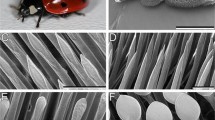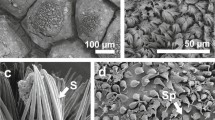Abstract
Geckos may represent the world’s most demanding adhesives application. The adhesive setae on the toes of climbing geckos must adhere strongly yet avoid fouling or attachment at inappropriate times. We tested the hypothesis that gecko setae are non-adhesive in their unloaded default state by comparing the water droplet contact angle (θ) of isolated setal arrays to the smooth surface of eye spectacle scales of tokay geckos (Gekko gecko). At equilibrium, θ was 98.3 ± 3.4° in spectacle scales of live geckos and 93.3 ± 3.5° in isolated spectacles. Isolated setal arrays were ultrahydrophobic, with θ of 160.6 ± 1.3° (means ± SD). The difference in θ of setal arrays and smooth spectacles indicates a very low contact fraction. Using Cassie’s law of surface wettability, we infer that less than 6.6% of the surface of unloaded setae is solid and at least 93.4% is air space. We calculated that the contact fraction must increase from 6.6% in the unloaded state to 46% in the loaded state to account for previously measured values of adhesion. Thus gecko setae may be non-sticky by default because only a very small contact fraction is possible without mechanically deforming the setal array.



Similar content being viewed by others
Abbreviations
- E :
-
Young’s modulus
- E eff :
-
Effective modulus
- f solid :
-
Fraction of surface area occupied by solid; contact fraction
- f air :
-
Fraction of surface area occupied by air
- γ :
-
Surface energy
- PSA:
-
Pressure sensitive adhesive
- PTFE:
-
Polytetrafluoroethylene
- θ :
-
Water droplet contact angle
- θ eq :
-
Equilibrium water droplet contact angle
- θ ad :
-
Advancing water droplet contact angle
- θ rec :
-
Receding water droplet contact angle
- W :
-
Adhesion energy
References
Alibardi L (2003) Ultrastructural autoradiographic and immunocytochemical analysis of setae formation and keratinization in the digital pads of the gecko Hemidactylus turcicus (Gekkonidae, Reptilia). Tissue Cell 35:288–296
Arzt E, Enders S, Gorb S (2002) Towards a micromechanical understanding of biological surface devices. Z Metallkunde 93:345–351
Arzt E, Gorb S, Spolenak R (2003) From micro to nano contacts in biological attachment devices. Proc Natl Acad Sci USA 100:10603–10606
Autumn K, Peattie A (2002) Mechanisms of adhesion in geckos. Integr Comp Biol 42:1081–1090
Autumn K, Liang YA, Hsieh ST, Zesch W, Chan W-P, Kenny WT, Fearing R, Full RJ (2000) Adhesive force of a single gecko foot-hair. Nature 405:681–685
Autumn K, Sitti M, Peattie A, Hansen W, Sponberg S, Liang YA, Kenny T, Fearing R, Israelachvili J, Full RJ (2002) Evidence for van der Waals adhesion in gecko setae. Proc Natl Acad Sci USA 99:12252–12256
Autumn K, Buehler M, Cutkosky M, Fearing R, Full RJ, Goldman D, Groff R, Provancher W, Rizzi AA, Saranli U, et al. (2005) Robotics in scansorial environments. Proc SPIE 5804:291–302
Autumn K, Hsieh ST, Dudek DM, Chen J, Chitaphan C, Full RJ (2006) Dynamics of geckos running vertically. J Exp Biol 209:260–272
Baier RE, Shafrin EG, Zisman WA (1968) Adhesion: mechanisms that assist or impede it. Science 162:1360–1368
Barthlott W, Neinhuis C (1997) Purity of the sacred lotus, or escape from contamination in biological surfaces. Planta 202:1–8
Barthlott W, Neinhuis C (1998) The lotus-effect: a paradigm for the use of a natural design for technical application. Am J Bot 85:6
Baum C, Meyer W, Stelzer R, Fleischer L-G, Siebers D (2002) Average nanorough skin surface of the pilot whale (Globicephala melas, Delphinidae): considerations on the self-cleaning abilities based on nanoroughness. Mar Biol 140:653–657
Bereiter-Hahn J, Matoltsy AG, Richards KS (1984) Biology of the integument 2: vertebrates. Springer, Berlin Heidelberg New York
Bonser RHC (2000) The Young’s modulus of ostrich claw keratin. J Mater Sci Lett 19:1039–1040
Bonser RHC, Purslow PP (1995) The Young’s modulus of feather keratin. J Exp Biol 198:1029–1033
Cassie A, Baxter S (1944) Wettability of porous surfaces. Trans Faraday Soc 40:546–551
Chen W, Fadeev AY, Hsieh MC, Oner D, Youngblood J, McCarthy T (1999) Ultrahydrophobic and ultralyophobic surface: some comments and examples. Langmuir 15:3395–3399
Dahlquist CA (1969) Pressure-sensitive adhesives. In: Patrick RL (ed) Treatise on adhesion and adhesives, vol 2. Dekker, New York, pp. 219–260
Dellit W-D (1934) Zur Anatomie und Physiologie der Geckozehe. Jena Z Naturw 68:613–656
Fraser RDB, Parry DAD (1996) The molecular structure of reptilian keratin. Int J Biol Macromol 19:207–211
Gao X, Jiang L (2004) Water-repellent legs of water striders. Nature 432:36
Gay C, Leibler L (1999) Theory of tackiness. Phys Rev Lett 82:936–939
Geisler B, Dittmore A, Gallery B, Stratton T, Fearing R, Autumn K (2005) Deformation of isolated gecko setal arrays: bending or buckling? 2. Kinetics. Society of Integrative and Comparative Biology, San Diego
Hansen W, Autumn K (2005) Evidence for self-cleaning in gecko setae. Proc Natl Acad Sci USA 102:385–389
Hiller U (1968) Untersuchungen zum Feinbau und zur Funktion der Haftborsten von Reptilien. Z Morphol Tiere 62:307–362
Huber G, Gorb S, Spolenak R, Arzt E (2005) Resolving the nanoscale adhesion of individual gecko spatulae by atomic force microscopy. Biol Lett 1:2–4
Irschick DJ, Austin CC, Petren K, Fisher R, Losos JB, Ellers O (1996) A comparative analysis of clinging ability among pad-bearing lizards. Biol J Linn Soc 59:21–35
Israelachvili J (1992) Intermolecular and surface forces. Academic, New York
Johnson KL (1985) Contact mechanics. Cambridge University Press, Cambridge
Johnson RE, Dettre RH (1963) Contact angle hysteresis I. Study of an idealized rough surface, chapter 7. In: Fowkes FM (ed) Advances in chemistry series, vol 43, American Chemical Society, Washington DC, pp. 112–129
Johnson KL, Kendall K, Roberts AD (1973) Surface energy and the contact of elastic solids. Proc R Soc Lond A 324:310–313
Kinloch AJ (1987) Adhesion and adhesives: science and technology. Chapman & Hall, New York
Maderson PFA (1964) Keratinized epidermal derivatives as an aid to climbing in gekkonid lizards. Nature 203:780–781
Neinhuis C (1997) Characterization and distribution of water-repellent, self-cleaning plant surfaces. Ann Bot 79:667–677
Patankar NA (2003) On the modeling of hydrophobic contact angles on rough surfaces. Langmuir 19:1249–1253
Patankar NA (2004) Mimicking the lotus effect: influence of double roughness structures and slender pillars. Langmuir 20:8209–8213
Persson BNJ (2003) On the mechanism of adhesion in biological systems. J Chem Phys 118:7614–7621
Persson BNJ, Gorb S (2003) The effect of surface roughness on the adhesion of elastic plates with application to biological systems. J Chem Phys 119:11437
Persson BNJ, Albohr O, Tartaglino U, Volokitin AI, Tosatti E (2005) On the nature of surface roughness with application to contact mechanics, sealing, rubber friction and adhesion. J Phys Condens Matter 17:R1–R62
Pocius AV (2002) Adhesion and adhesives technology: an introduction, 2nd edn. Hanser Verlag, Munich
Ruibal R, Ernst V (1965) The structure of the digital setae of lizards. J Morphol 117:271–294
Russell AP (1975) A contribution to the functional morphology of the foot of the tokay, Gekko gecko (reptilia, gekkonidae). J Zool (Lond) 176:437–476
Russell AP (1979) Parallelism and integrated design in the foot structure of gekkonine and diplodactyline geckos. Copeia 1979:1–21
Russell AP (1986) The morphological basis of weight-bearing in the scansors of the tokay gecko (reptilia: Sauria). Can J Zool 64:948–955
Schleich HH, Kästle W (1986) Ultrastrukturen an Gecko-Zehen (reptilia: Sauria: Gekkonidae). Amphib-Reptil 7:141–166
Sitti M, Fearing RS (2003) Synthetic gecko foot-hair micro/nano structures as dry adhesives. J Adhes Sci Technol 17:1055–1073
Spolenak R, Gorb S, Gao HJ, Arzt E (2004) Effects of contact shape on the scaling of biological attachments. Proc Royal Soc Lond A 461:305–319
Spolenak R, Gorb S, Arzt E (2005) Adhesion design maps for bio-inspired attachment systems. Acta Biomater 1:5–13
Stewart G, Daniel R (1972) Scales of the lizard gekko gecko: surface structure examined with the scanning electron microscope. Copeia 1972(2):252–257
Vinson J, Vinson J-M (1969) The saurian fauna of the Mascarene Islands. Bull Maurit Inst 6:203–320
Wainwright SA, Biggs WD, Currey JD, Gosline JM (1982) Mechanical design in organisms. Princeton University Press, Princeton
Williams EE, Peterson JA (1982) Convergent and alternative designs in the digital adhesive pads of scincid lizards. Science 215:1509–1511
Wolfram E, Faust R (1978) Liquid drops on a tilted plate, contact angle hysteresis and the young contact angle. In: Padday JF (ed) Wetting, spreading, and adhesion. Academic, London, pp. 213–226
Acknowledgments
We thank Jon Barnes, Andrew Dittmore, Valeurie Friedman, Bill Geisler, Stas Gorb, Jacob Israelachvili, Allen Liu, Carmel Majidi, and an anonymous reviewer. Supported by DARPA N66001-03-C-8045, DARPA N660001-00-C-8047, NSF-NIRT 0304730, and Johnson & Johnson/DePuy Mitek Corporation. This study complies with “Principles of animal care,” publication no. 86-23, revised 1985 of the National Institute of Health, and also with the current laws of the USA.
Author information
Authors and Affiliations
Corresponding author
Rights and permissions
About this article
Cite this article
Autumn, K., Hansen, W. Ultrahydrophobicity indicates a non-adhesive default state in gecko setae. J Comp Physiol A 192, 1205–1212 (2006). https://doi.org/10.1007/s00359-006-0149-y
Received:
Revised:
Accepted:
Published:
Issue Date:
DOI: https://doi.org/10.1007/s00359-006-0149-y




